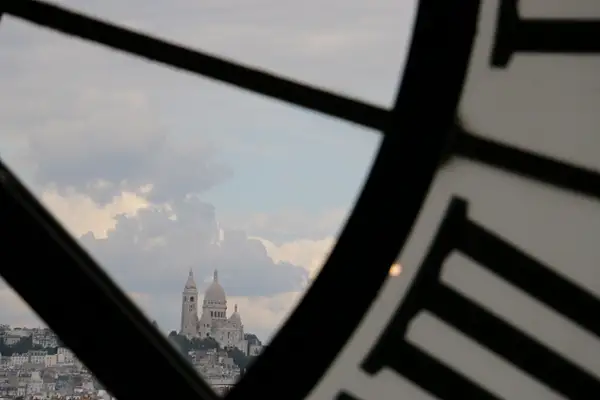


View of Sacre Cour on Montmarte from the clock of Musée d'Orsay |
View of Sacre Cour on Montmarte from the clock of Musée d'Orsay |
Entrance-Musée d'Orsay. It's origins as a grand train station are evident
The museum building was originally a railway station, Gare d'Orsay, constructed for the Chemin de Fer de Paris à Orléans and finished in time for the 1900 Exposition Universelle. It was the terminus for the railways of southwestern France until 1939. By 1939 the station's short platforms had become unsuitable for the longer trains that had come to be used for mainline services. After 1939 it was used for suburban services and part of it became a mailing centre during World War II.In 1970, permission was granted to demolish the station but Jacques Duhamel, Minister for Cultural Affairs, ruled against plans to build a new hotel in its stead. The station was put on the supplementary list of Historic Monuments and finally listed in 1978. The suggestion to turn the station into a museum came from the Directorate of the Museums of France. The idea was to build a museum that would bridge the gap between the Louvre and the National Museum of Modern Art at the Georges Pompidou Centre.
|
Hercules the Archer, Musée d'Orsay by Emile-Antoine Bourdelle
Trained first in Montauban and then in Toulouse, Bourdelle started work as an assistant in Rodin's studio. This work is remarkable both for its tension and for its balanced construction. The dynamics come from the interaction of solids and voids, brutal force and balance. The figure denotes power, high-strung energy, pulled taut between the arm bending the bow and the foot braced against the rock.
|
Musée d'Orsay Clock, designed by Victor Laloux, Main Hall |
Passerelle Léopold-Sédar-Senghor
The passerelle Léopold-Sédar-Senghor is a footbridge over the River Seine in the 7th arrondissement of Paris. This relatively new bridge links the Musée d'Orsay and the Jardin des Tuileries (Tuileries Gardens) and was built between 1997 and 1999 under the direction of the engineer and architect Marc Mimram. Crossing the Seine with a single span and no piers, this metallic bridge is architecturally unique and covered in exotic woods
|
The Grande Palais from near Musée d'Orsay |
The Seine with the Louvre on the left and Musée d'Orsay on the right. Center-Pont Royal.
The Pont Royal is a bridge crossing the river Seine in Paris. It is the third oldest bridge in Paris, after the Pont Neuf and the Pont Marie.
|
The Louvre and Pont Royal |
Musée d'Orsay viewed from Passerelle Léopold-Sédar-Senghor |
King Henri IV on the Pont Neuf
At the point where the bridge crosses the Île de la Cité, there stands a bronze equestrian statue of king Henry IV, originally commissioned from Giambologna under the orders of Marie de Médicis, Henri’s widow and Regent of France, in 1614. After his death, Giambologna's assistant Pietro Tacca completed the statue, which was erected on its pedestal by Pietro Francavilla, in 1618. It was destroyed in 1792 during the French Revolution, but was rebuilt in 1818, following the restoration of the Bourbon monarchy. Bronze for the new statue was obtained with the bronze from a statue of Louis Charles Antoine Desaix, as well as from the statue of Napoleon in Place Vendôme, which was melted down. The new statue was cast from a mold made using a surviving cast of the original. Inside the statue, the new sculptor François-Frédéric Lemot put four boxes, containing a history of the life of Henry IV, a 17th-century parchment certifying the original statue, a document describing how the new statue was commissioned.
|
Saint-Jacques Tower (Tour Saint-Jacques) and Théâtre du Châtelet
Saint-Jacques Tower (Tour Saint-Jacques) is a monument located in the 4th arrondissement of Paris, France, on Rue de Rivoli at Rue Nicolas Flamel. This 52-metre (171 ft) Flamboyant Gothic tower is all that remains of the former 16th-century Church of Saint-Jacques-de-la-Boucherie ("Saint James of the butchery"), which was demolished in 1797, during the French Revolution, - like many other churches, leaving only the tower. The Théâtre du Châtelet is a theatre and opera house, located in the place du Châtelet in the 1st arrondissement of Paris, France.
|
Georgia in the Conciergere |
Vaulted ceilings-Conciergerie
The Hall of the Guards, one of the largest surviving medieval parts of the Conciergerie
|
La Conciergerie Horloge (Clock)
This magnificent clock dates from the 15th Century (although it has been restored several times since, the last one being 1909) and was the first public clock in Paris.
|